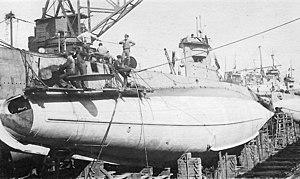
USS Seawolf (SS-197), a Sargo-class submarine, was the second submarine of the United States Navy named for the seawolf.

USS Dace (SS-247), a Gato-class submarine, was the first submarine of the United States Navy to be named for any of several small North American fresh-water fishes of the carp family.
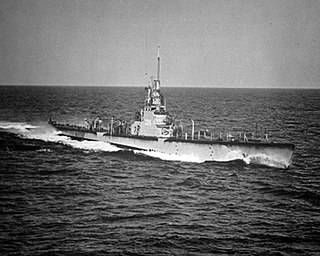
USS Cod (SS/AGSS/IXSS-224) is a Gato-class submarine, the only vessel of the United States Navy to be named for the cod, an important and very popular food fish of the North Atlantic and North Pacific.

USS Bonefish (SS-223) was a Gato-class submarine, the first United States Navy ship to be named for the bonefish.

USS Triton (SS-201) was the fourth Tambor-class submarine to be commissioned in the United States Navy in the years leading up to the country's December 1941 entry into World War II. Her wartime service was in the Pacific Ocean. She completed five patrols in the following 14 months, and is credited with the sinking of over 20,000 tons of Japanese shipping and warships. She was lost with all hands on or around March 15, 1943. Of the twelve Tambor-class submarines, only five survived the war.

USS Sailfish (SS-192), was a US Sargo-class submarine, originally named Squalus. As the Squalus, the submarine sank off the coast of New Hampshire during test dives on 23 May 1939. The sinking drowned 26 crew members, but an ensuing rescue operation, using the McCann Rescue Chamber for the first time, saved the lives of the remaining 33 aboard. The Squalus was salvaged in late 1939 and recommissioned as Sailfish.

USS Tang (SS-306) was a Balao-class submarine of World War II, the first ship of the United States Navy to bear the name Tang. She was built and launched in 1943, serving until being sunk by her own torpedo off China in the Taiwan Strait on 24 October 1944.

USS Snook (SS-279), a Gato-class submarine, was the first ship of the United States Navy to be named for the common snook, an Atlantic marine fish that is bluish-gray above and silvery below a black lateral line.

USS Paulding (DD-22) was the lead ship of Paulding-class destroyers in the United States Navy. She was named for Rear Admiral Hiram A. Paulding (1797-1878). She was in commission from 1910 to 1919 and saw service in World War I.

USS Peto (SS-265), a Gato-class submarine, was a ship of the United States Navy named for the peto, a sharp-nosed tropical fish of the mackerel family.
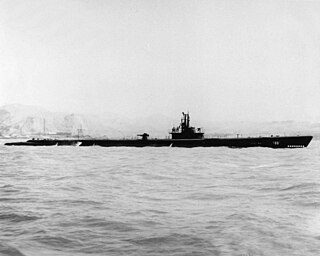
The first USS Trepang (SS/AGSS-412) was a Balao-class submarine in the United States Navy. She was named for the trepang, a marine animal sometimes called a "sea slug" or a "sea cucumber," having a long, tough, muscular body and found in the coral reefs of the East Indies.

The first USS Batfish (SS/AGSS-310) is a Balao-class submarine, known primarily for the remarkable feat of sinking three Imperial Japanese Navy submarines in a 76-hour period, in February 1945. USS Batfish is the first vessel of the United States Navy to be named for the batfish, a fish found off the coast of Peru, at depths ranging from 3 to 76 meters.

The second USS Paul Jones was a Bainbridge-class destroyer in the United States Navy. She was named for John Paul Jones.

The first USS Jenkins (DD-42) was a modified Paulding-class destroyer in the United States Navy during World War I. She was named for Rear Admiral Thornton A. Jenkins.
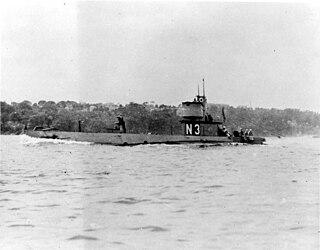
USS N-3 (SS-55) was a N-class coastal defense submarine in commission in the United States Navy from 1917 to 1926. She saw service during World War I.
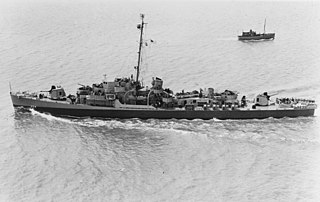
USS Rudderow (DE-224) was the lead ship of her class of destroyer escorts, in service with the United States Navy from 1944 to 1947. After spending decades in reserve, she was sold for scrap in 1970.
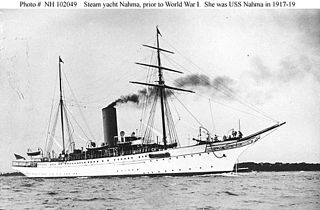
USS Nahma (SP-771) was a United States Navy patrol vessel in commission from 1917 to 1919. She operated during and in the immediate aftermath of World War I, seeing service in the Atlantic Ocean, Mediterranean Sea, Aegean Sea, and Black Sea. Prior to her U.S. Navy servce, she was the private yacht Nahma, a sister ship of the yacht which became the U.S. Navy patrol vessel and presidential yacht USS Mayflower.
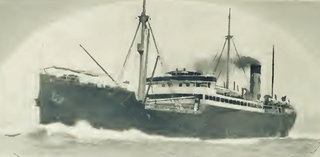
USS Wilhelmina (ID-2168) was a transport for the United States Navy during World War I. Built in 1909 for Matson Navigation Company as SS Wilhelmina, she sailed from the West Coast of the United States to Hawaii until 1917. After her war service, she was returned to Matson and resumed Pacific Ocean service. In the late 1930s she was laid up in San Francisco, California, until sold to a British shipping company in 1940. While a part of a convoy sailing from Halifax, Nova Scotia, to Liverpool, she was sunk by U-94 on 2 December 1940.

The action of 17 November 1917 was a naval battle of the First World War. The action was fought between a German U-boat and two United States Navy destroyers in the North Atlantic Ocean.

United States Navy operations during World War I began on April 6, 1917, after the formal declaration of war on the German Empire. The American navy focused on countering enemy U-boats in the Atlantic Ocean and the Mediterranean Sea while convoying men and supplies to France and Italy. Because of United States's late entry into the war, her capital ships never engaged the German fleet and few decisive submarine actions occurred.
